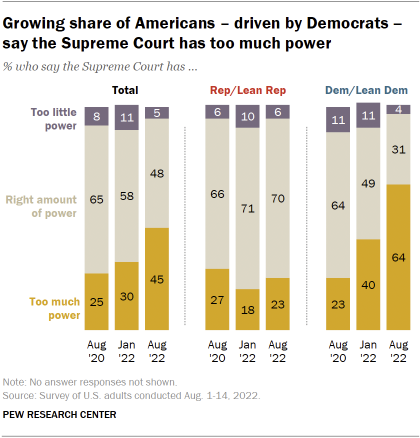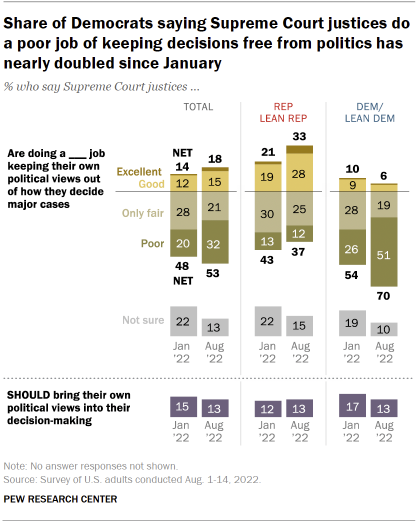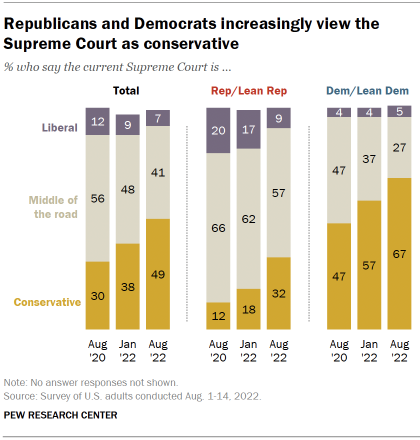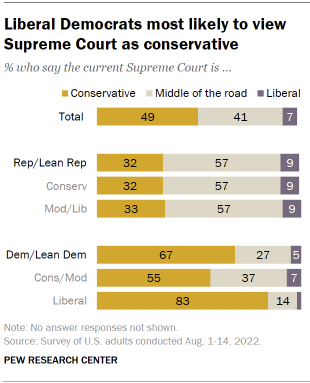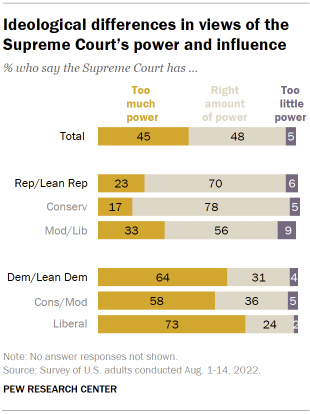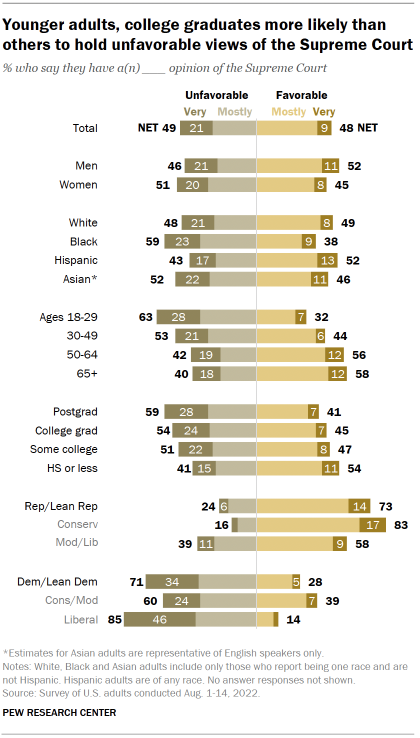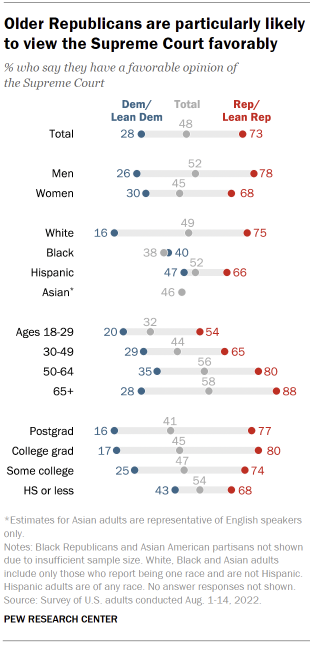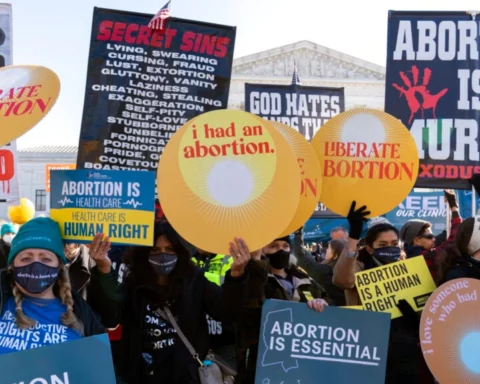Share of Democrats who say the court has too much power has nearly tripled since 2020
Americans’ ratings of the Supreme Court are now as negative as – and more politically polarized than – at any point in more than three decades of polling on the nation’s highest court.
Following a term which saw the Dobbs v. Jackson ruling ending the federal guarantee of the right to abortion along with several other high profile cases that often split the justices along largely ideological lines, this shift in views of the court has been driven by a transformation in Democrats’ views.
Just 28% of Democrats and Democratic-leaning independents now view the court favorably, down 18 percentage points since January and nearly 40 points since 2020. Positive views of the court among Republicans and Republican leaners have increased modestly since the start of the year (73% now, 65% then).
As a result, the partisan gap in favorable views of the Supreme Court – 45 percentage points – is wider by far than at any point in 35 years of polling on the court.
The new national survey by Pew Research Center, conducted among 7,647 adults from Aug. 1 to 14, finds the public overall is split in its views of the Supreme Court: 48% of the public holds a favorable view of the court, while a similar share (49%) holds an unfavorable view.
Positive opinions of the Supreme Court have steadily declined among the U.S. public since August 2020, when 70% of Americans held favorable views of the court. Today, favorability ratings of the court are similar to where they stood in 2015, shortly after the court’s ruling on Obergefell v. Hodges, which established a constitutional right to same-sex marriage (48% held a favorable view of the court then, while 43% held an unfavorable view).
The wide partisan divisions in overall attitudes toward the Supreme Court also are reflected in contrasting views of the court’s power and ideology, as well as in opinions about whether the court’s justices keep their decisions free from political influences.
Today, 45% of U.S. adults say the court has too much power, up 15 percentage points from the share who said this in January (30%). Still, about half of the public (48%) currently says the Supreme Court has the “right amount of power”; just 5% say the court has too little power.
While Republicans largely say that the court has the right amount of power, today nearly two-thirds of Democrats (64%) say the Supreme Court has too much power, up from the 40% who said this in January of this year, and almost three times the share who said this in August 2020 (23%). About a third of Democrats (31%) say the court has about the right amount of power.
Growing shares of Democrats also say the Supreme Court has a conservative tilt (67% say this today, up from 57% who said this in January). And Democrats have grown more skeptical of whether Supreme Court justices keep their own personal bias out when deciding major cases.
About half of Democrats (51%) now say the justices on the court are doing a poor job of keeping their own political views out of their judgments on major cases, nearly double the share who said this in January (26%). Another 19% of Democrats say the justices do an only fair job of keeping their political views out of their decision-making. Just 6% say they do at least a good job of this.
Views of the justices’ impartiality among Republicans, who also view the court as more moderate, are divided: While a third of Republicans say the justices are doing at least a good job keeping their own political views out of how they decide major cases, a slightly larger share (37%) say the justices are doing an only fair or poor job at doing this. Another 15% of Republicans say they are unsure whether Supreme Court justices eliminate their personal bias when deciding major cases.
The share of Republicans who say the court’s justices do an excellent or good job keeping their decisions free from politics has increased 12 points since January (from 21% to 33%).
Rising share of public says the Supreme Court has a conservative tilt
The share of Americans who say the Supreme Court is conservative has steadily risen over the last two years: Today, about half of Americans (49%) say the court is conservative, up from the 30% who held this view in August 2020. Another 41% of the public says the court is “middle of the road,” while just 7% view it as liberal.
In 2020, Democrats and Democratic-leaning independents were divided in their opinion of whether the court was conservative or more moderate (47% each). Today, two-thirds of Democrats say the Supreme Court is conservative, while 27% say it is “middle of the road.”
While the share of Republicans and Republican leaners who say the court is conservative has also grown (roughly a third now say this, compared with 12% who said this in 2020), a majority of Republicans (57%) view the Supreme Court as “middle of the road.”
Among Democrats, views of the court’s ideological tilt differ by ideology. About eight-in-ten liberal Democrats (83%) view the current Supreme Court as conservative, compared with a smaller majority of conservative and moderate Democrats (55%).
Similarly, there are ideological differences among Democrats in views of the court’s power: While 64% of all Democrats say the court has too much power, about three-quarters of liberal Democrats (73%) hold this view, compared with 58% of conservative and moderate Democrats.
Among Republicans, moderates and liberals are more likely than conservatives to say the Supreme Court has too much power (33% vs. 17%). Still, majorities of conservative (78%) and moderate and liberal Republicans (56%) say the court has the right amount of power. There are no ideological differences among Republicans in perceptions of the ideology of the Supreme Court.
Views of the Supreme Court divided by age, education and partisanship
The public is roughly evenly split in views of the Supreme Court, with about half (48%) saying they have very (9%) or mostly favorable (39%) views of the court, while 49% say they have very (21%) or mostly unfavorable (28%) views of the court.
But views of the court differ across demographic groups.
Men are slightly more likely to view the Supreme Court favorably (52%) than unfavorably (46%), while women are slightly more likely to hold unfavorable views of the court (45% favorable vs. 51% unfavorable).
A majority of Black adults (59%) have an unfavorable view of the court, while 38% hold a favorable view. About half of Hispanic (52%) and White (49%) adults hold a favorable view, as does a similar share (46%) of Asian adults.
Older adults are more likely than those who are younger to have favorable views of the court: About six-in-ten adults ages 50 and older (57%) have a favorable view of the Supreme Court, compared with 44% of those ages 30 to 49 and about a third of those under 30 (32%).
And while opinions of the Supreme Court are fairly divided among those with some college experience or less formal education (51% hold favorable views, 46% unfavorable), opinions among those with a bachelor’s degree or more education are negative on balance (56% unfavorable, 43% favorable).
There is now a wide partisan divide in views of the Supreme Court, with Republicans holding far more favorable views of the court than Democrats.
About three-quarters of Republicans and Republican-leaning independents say they have a mostly (59%) or very favorable (14%) view of the court, compared with 24% who say they have an unfavorable view of the court. However, there also is an ideological gap within the GOP: About eight-in-ten conservative Republicans (83%) view the court positively today, compared with a narrower majority of moderate and liberal Republicans (58%).
Democrats, by contrast, have far more negative views of the Supreme Court. About seven-in-ten Democrats and Democratic leaners say they have an unfavorable opinion of the court, a view held by 85% of liberal Democrats and 60% of conservative and liberal Democrats. And while 46% of liberal Democrats say they have very unfavorable views of the court, about a quarter of conservative and moderate Democrats hold this view.
Within each partisan coalition, demographic groups differ in their views of the Supreme Court.
For example, older Republicans are far more likely than younger Republicans to hold favorable views of the court. Fully 84% of Republicans 50 and older hold favorable views of the court, compared with 65% of those 30 to 49 and 54% of those younger than 30.
Older Republicans view the court more favorably than they did early this year. The share of Republicans ages 50 to 64 who view the Supreme Court positively has increased 12 points since January (from 68% to 80%). And favorable views have risen 15 points among those 65 and older (from 73% to 88%). By contrast, views of Republicans under the age of 50 are relatively unchanged over the last few months.
Among Democrats, White adults (16%) are far less likely than Black (40%) or Hispanic adults (47%) to view the Supreme Court positively. The share of White Democrats who hold favorable views toward the Supreme Court has declined 26 points since January (from 42% to 16%), while views among Black and Hispanic Democrats have seen less change.
Democrats with lower levels of educational attainment view the court more positively than do those with more formal education. Just 17% of Democratic college graduates express positive views of the court, compared with 43% of those with no more than a high school diploma. And since January, there has been a larger decline in favorable views of the court among Democratic college graduates (from 42% to 17%) than among those with less education (from 47% to 35%).
Acknowledgments
This report is a collaborative effort based on the input and analysis of the following individuals:
Research team
Carroll Doherty, Director, Political Research
Jocelyn Kiley, Associate Director, Political Research
Baxter Oliphant, Senior Researcher
Andrew Daniller, Research Associate
Hannah Hartig, Research Associate
Gabe Borelli, Research Associate
Amina Dunn, Research Analyst
Ted Van Green, Research Analyst
Andy Cerda, Research Assistant
Communications and editorial
Nida Asheer, Communications Manager
Talia Price, Communications Associate
David Kent, Senior Copy Editor
Graphic design and web publishing
Peter Bell, Design Director
Alissa Scheller, Information Graphics Designer
Reem Nadeem, Associate Digital Producer
Methodology
Andrew Mercer, Senior Research Methodologist
Dorene Asare-Marfo, Panel Manager
Dana Popky, Associate Panel Manager
Arnold Lau, Research Methodologist



